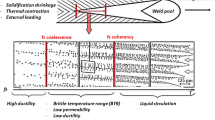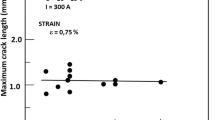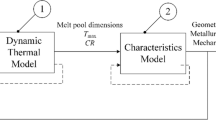Abstract
Solidification cracking is a weld defect common to certain susceptible alloys rendering many of them unweldable. It forms and grows continuously behind a moving weld pool within the two-phase mushy zone and involves a complex interaction between thermal, metallurgical, and mechanical factors. Research has demonstrated the ability to minimize solidification cracking occurrence by using appropriate welding parameters. Despite decade’s long efforts to investigate weld solidification cracking, there remains a lack of understanding regarding the particular effect of travel speed. While the use of the fastest welding speed is usually recommended, this rule has not always been confirmed on site. Varying welding speed has many consequences both on stress cells surrounding the weld pool, grain structure, and mushy zone extent. Experimental data and models are compiled to highlight the importance of welding speed on solidification cracking. This review is partitioned into three parts: part I focuses on the effects of welding speed on weld metal characteristics, part II reviews the data of the literature to discuss the importance of selecting properly the metrics, and part III details the different methods to model the effect of welding speed on solidification cracking occurrence.














Similar content being viewed by others
Abbreviations
- f s :
-
Solid fraction
- p :
-
Pressure
- t :
-
Time
- v L :
-
Liquid flow velocity
- v T :
-
Liquidus isotherm velocity
- x :
-
Distance from weld center
- CSZ:
-
Crack susceptible zone
- G :
-
Temperature gradient
- HCS:
-
Hot cracking susceptibility
- K :
-
Thermal conductivity
- SPV:
-
Maximum volumetric flow rate
- SRG:
-
Maximum volumetric solidification shrinkage
- T :
-
Temperature
- T L :
-
Liquidus temperature
- T S :
-
Solidus temperature
- α :
-
Thermal diffusivity
- β :
-
Solidification shrinkage
- δ :
-
Transverse displacement
- \( \dot{\delta} \) :
-
Rate of transverse displacement
- ε :
-
Strain
- \( \dot{\varepsilon} \) :
-
Strain rate
- μ :
-
Viscosity
- λ 2 :
-
Secondary dendrite arm spacing
References
Nguyen TC, Weckman DC, Johnson DA, Kerr HW (2006) High speed fusion weld bead defects. Sci Technol Weld Join 11:618–633. https://doi.org/10.1179/174329306X128464
Nguyen TC, Weckman DC, Johnson DA, Kerr HW (2005) The humping phenomenon during high speed gas metal arc welding. Sci Technol Weld Join 10:447–459. https://doi.org/10.1179/174329305X44134
J Campbell, Castings, Elsiever, 2003
Coniglio N, Cross CE (2013) Initiation and growth mechanisms for weld solidification cracking. Int Mater Rev 58:375–397. https://doi.org/10.1179/1743280413Y.0000000020
Borland JC (1979) Fundamentals of solidification cracking in welds - part 1. Weld Met Fabr:19–29
CE Cross, On the origin of weld solidification cracking, in: Hot Crack. Phenom. Welds, 2005: pp. 3–18
CE Cross, N Coniglio, Weld solidification cracking: critical conditions for crack initiation and growth, in: Hot Crack. Phenom. Welds II, 2008: pp. 39–58
Eskin DG, Katgerman L (2007) A quest for a new hot tearing criterion. Metall. Mater. Trans. A Phys. Metall. Mater. Sci. 38(A):1511–1519. https://doi.org/10.1007/s11661-007-9169-7
Lundin CD, Chou CPD (1983) Hot cracking susceptibility of austenitic stainless steel weld metals. Weld Res Counc 289:1–79 http://www.aws.org/wj/supplement/WJ_1982_03_s82.pdf
Kou S (2015) A criterion for cracking during solidification. Acta Mater 88:366–374. https://doi.org/10.1016/j.actamat.2015.01.034
Borland JC (1979) Fundamentals of solidification cracking in welds - part 2. Weld Met Fabr 47:99–107
Hull WG, Adams D (1954) Part II - review of published information on weld cracking in aluminium alloys with particular reference to Al-Mg-Si alloys. Br Weld J:464–467
Saveiko VN (1961) Theory of hot cracking. Russ Cast Prod:453–456
Dickhaus CH, Ohm L, Engler S (1994) Mechanical properties of solidifying shells of aluminium alloys. AFS Trans 101:677–684
Lahaie DJ, Bouchard M (2001) Physical modeling of the deformation mechanisms of semisolid bodies and a mechanical criterion for hot tearing. Met Mat Trans Bt Trans 32B:697–705
JA Brooks, JJ Dike, Modeling weld solidification cracking behavior in aluminum alloys-analysis of fracture initiation, in: Trends weld. Res. Proc. 5th Int. Conf. Mater. Park. Ohio, USA, 2005: pp. 695–700
Pellini WS (1952) Strain theory of hot tearing. Foundry. 80:125–199
Prokhorov NN, Gavrilyuk MN (1971) Strain behaviour during solidification after welding. Svar Proiz 6:5–9
Senda T, Matsuda T, Takano F, Watanabe G, Kobayashi K, Matsuzaka T (1971) Fundamental investigations on solidification crack susceptibility for weld metals with trans-varestraint test. Trans. JWS 2:1–22. https://doi.org/10.2207/qjjws1943.41.709
Pumphrey WI, Lyons JV (1948) Cracking during the casting and welding of the more common binary aluminum alloys. JIM. 74:439–455
Borland JC (1961) Suggested explanation of hot cracking in mild and low alloy steel welds. Br Weld J:526–540
Pumphrey WI, Moore DC (1947) Cracking during and after solidification in some aluminium-copper-magnesium alloys of high purity. 1JIM 73:425–438
Bishop HF, Ackerlind CG, Pellini WS (1952) Metallurgy and mechanics of hot tearing. TAFS. 60:818–833
C Bernhard, R Pierer, CM Chimani, A new hot tearing criterion for the continuous casting of steel, SP’07, 5th Decenn. Conf. Solidif. Process. Sheffield, UK, 23–25 July 2007. (2007) 525–530
Apblett WR, Pellini WS (1954) Factors which influence weld hot cracking. Weld. J:83s–90s
M’Hamdi M, Mo A, Fjær HG (2006) TearSim: a two-phase model addressing hot tearing formation during aluminum direct chill casting. Metall. Mater. Trans. A. 37:3069–3083. https://doi.org/10.1007/s11661-006-0188-6
A Mo, I Farup, Hot tearing and thermally induced deformation in the mushy zone, in: Model. Cast. Welding, Adv. Solidif. Process. IX, 2000: pp. 56–62
M’Hamdi M, Ellingsen K, Mortensen D, A three-phase approach for th emodelling of hot tearing formation in DC casting of aluminium ingots, in: Proc. 5th Decenn. Int. Conf. Solidif. Process., Sheffield, 2007: pp. 536–539
Mhamdi M, Mo A, Martin CL (2002) Two-phase modelling directed towards hot tearing formation in aluminium direct chill casting. Met Trans A 33A:2081–2093
Nakata K, Matsuda F (1995) Evaluations of ductility characteristics and cracking susceptibility of Al alloys during welding. Trans JWRI 24:83–94
Novikov II, Grushko OE (1995) Hot cracking susceptibility of Al–Cu–Li and Al–Cu–Li–Mn alloys. Mater Sci Technol 11:926–932. https://doi.org/10.1179/mst.1995.11.9.926
H Nagaumi, T Umeda, Prediction of internal cracking in a direct-chill cast, high strength, Al-Mg-Si alloy, J Light Met 2 (2002) 161–167. https://doi.org/10.1016/S1471-5317(02)00042-1
Ridolfi MR, Fraschetti S, De Vito A, Ferro LA (2010) Mathematical modeling of hot tearing in the solidification of continuously cast round billets. Metall Mater Trans B Process Metall Mater Process Sci 41:1293–1309. https://doi.org/10.1007/s11663-010-9427-8
El-Bealy MO (2012) Interdendritic strain and macrosegregation-coupled phenomena for interdendritic crack formation in direct-chill cast sheet ingots. Metall Mater Trans B Process Metall Mater Process Sci 43:635–656. https://doi.org/10.1007/s11663-011-9616-0
Suyitno WH, Kool L (2003) Ketgerman, Evaluation of mechanical and non-mechanical hot tearing criteria for DC casting of an aluminum alloy. Light Met 2003:753–758
Coniglio N, Cross CE (2009) Mechanisms for solidification crack initiation and growth in aluminum welding. Metall. Mater. Trans. A. 40:2718–2728. https://doi.org/10.1007/s11661-009-9964-4
Rappaz M, Drezet J, Gremaud M (1999) A new hot-tearing criterion. 30:449–455
TW Clyne, GJ Davies, Comparison between experimental data and theoretical predictions relating to dependence of solidification cracking on composition, Solidif. Cast. Met. Proc. an Int. Conf. Solidif. (1979) 275–278. https://ndlopac.ndl.go.jp/F/KR79PSQ7E4N6B2QTNC1PUUX3YKJ62SQARV52BE1X1H4G3HDCR2-31212?func=full-set-set&set_number=670580&set_entry=000012&format=999
Katgerman L (1982) A mathematical model for hot cracking of aluminum alloys during D.C. casting. JOM 34:46–49. https://doi.org/10.1007/BF03339110
Hatami N, Babaei R, Dadashzadeh M, Davami P (2008) Modeling hot tearing during solidification. J Mater Process Technol 205:506–513
Mathier V, Vernède S, Jarry P, Rappaz M (2009) Two-phase modeling of hot tearing in aluminum alloys: applications of a semicoupled method. Metall. Mater. Trans. A Phys. Metall. Mater. Sci. 40:943–957. https://doi.org/10.1007/s11661-008-9772-2
Bellet M, Cerri O, Bobadilla M, Chastel Y (2009) Modeling hot tearing during solidification of steels: assessment and improvement of macroscopic criteria through the analysis of two experimental tests. Metall. Mater. Trans. A Phys. Metall. Mater. Sci. 40:2705–2717. https://doi.org/10.1007/s11661-009-9955-5
Mihanyar S, Mo A, M’Hamdi M, Ellingsen K (2011) Modeling of de-cohesion and the initiation of hot tearing in coherent mushy zones of metallic alloys. Metall Mater Trans A Phys Metall Mater Sci 42:1887–1895. https://doi.org/10.1007/s11661-010-0581-z
J Drezet, M Gremaud, R Graf, M Gäumann, A new hot tearing criterion for steel, in: 4th ECCC, 2002: pp. 14–16
JM Drezet, D Allehaux, Application of the Rappaz-Drezet-Gremaud hot tearing criterion to welding of aluminium alloys, in: Springer (Ed.), Hot crack. Phenom. Welds II, 2008: pp. 27–45. https://doi.org/10.1007/978-3-540-78628-3_2
JM Drezet, M Rappaz, Prediction of hot tears in DC-cast aluminum billets, in: J.L. Anjier (Ed.), Light Met. 2001, TMS, 2001: pp. 887–893
Easton M, Sweet L, Wang H, Grandfield J, Davidson CJ, Stjohn DH, Couper MJ (2012) Observation and prediction of the hot tear susceptibility of ternary Al-Si-Mg alloys. Metall. Mater. Trans. A Phys. Metall. Mater. Sci. 43:3227–3238. https://doi.org/10.1007/s11661-012-1132-6
Hagenlocher C, Weller D, Weber R, Graf T (2019) Analytical description of the influence of the welding parameters on the hot cracking susceptibility of laser beam welds in aluminum alloys. Metall Mater Trans A 50:5174–5180. https://doi.org/10.1007/s11661-019-05430-7
Monroe C, Beckermann C (2005) Development of a hot tear indicator for steel castings. Mater Sci Eng A 413–414:30–36. https://doi.org/10.1016/j.msea.2005.09.047
M’Hamdi M, Mo A (2005) On modelling the interplay between microporosity formation and hot tearing in aluminum direct-chill casting. Mat Sci Eng A 413–414:105–108
JF Grandfield, CJ Davidson, JA Taylor, Applciation of a new hot tearing analysis to horizontal direct chill cast magnesium alloy AZ91, in: TMS (Ed.), Light Met. 2001, 2001: pp. 895–901
W Rindler, K Kozeschnik, N Enzinger, B Buchmayr, A modified hot tearing criterion for steels, in: Math. Model. Weld Phenom. 6, Maney, 2002: pp. 819–835
U Feurer, Influence of alloy composition and solidification conditions on dendrite arm spacing, feeding, and hot tearing properties of aluminum alloys, in: Proc. Int. Symp. Eng. Alloy., Delft, 1977: pp. 131–145
Liu J, Kou S (2015) Effect of diffusion on susceptibility to cracking during solidification. Acta Mater 100:359–368. https://doi.org/10.1016/j.actamat.2015.08.064
Soysal T, Kou S (2018) A simple test for assessing solidification cracking susceptibility and checking validity of susceptibility prediction. Acta Mater 143:181–197. https://doi.org/10.1016/j.actamat.2017.09.065
Geng S, Jiang P, Shao X, Mi G, Wu H, Ai Y (2018) Effects of back-diffusion on solidification cracking susceptibility of Al-Mg alloys during welding: a phase-field study. Acta Mater 160:85–96. https://doi.org/10.1016/j.actamat.2018.08.057
K Liu, S Kou, Susceptibility of magnesium alloys to solidification cracking, Sci Technol Weld Join 0 (2019) 1–7. https://doi.org/10.1080/13621718.2019.1681160
CE Cross, DL Olson, Hot tearing model to assess aluminum weldability, in: Alum. Alloy. - Their Phys. Mech. Prop. Vol. III, Charlottesville, 1986: pp. 1869–1875
Rappaz M, Jacot A, Boettinger WJ (2003) Last-stage solidification of alloys: theoretical model of dendrite-arm and grain coalescence. Met Mat Trans Alurgical 34A:467–479
F Bodaghi, M Movahedi, AH Kokabi, R Tavakoli, Effect of solid fraction, grain misorientation and grain boundary energy on solidification cracking in weld of Al-Cu aluminum alloys, Mater. Res. Express. 6 (2019). https://doi.org/10.1088/2053-1591/ab20ee
Davidson C, Viano D, Lu L, Stjohn D (2006) Observation of crack initiation during hot tearing. Int J Cast Met Res 19:59–65
Campbell J, Tiryakiog M (2012) Bifilm defects in Ni-based alloy castings. Met Mat Trans B 43B:902–914. https://doi.org/10.1007/s11663-012-9655-1
Fabrègue D, Deschamps A, Suéry M, Proudhon H (2007) Hot tearing during laser butt welding of 6xxx aluminium alloys: process optimisation and 2D/3D characterisation of hot tears, in: Hot crack. Phenom. Welds II:241–253
David SA, White CL (1986) Formation of hot cracks in austenitic stainless steel welds — solidification cracking. Weld. Res. Suppl 209-s:203–212
M Shibahara, H Serizawa, H Murakawa, Finite element method for hot cracking analysis using temperature dependent interface element, in: Hot crack. Phenom. Welds, Springer, 2005: pp. 253–257
DG Eskin, Suyitno L Katgerman, Mechanical properties in the semi-solid state and hot tearing of aluminium alloys, Prog Mater Sci 49 (2004) 629–711. https://doi.org/10.1016/S0079-6425(03)00037-9
Braccini M, Martin CL, Suery M, Brechet Y (2000) Hot tearing phenomena in Al-Cu alloys: grain refinement effect. Mater Tech 5–6:19–24
M Braccini, C Martin, M Suery, Relation Between mushy zone rheology and hot tearing phenomena in Al-Cu alloys, Model. Cast. Weld. Adv. Solidif. Process. IX. (2000) 18–24. papers3://publication/uuid/B3582EAE-4EBC-48C2-8D43-F45001DFB1A4
Bhagavath S, Cai B, Atwood R, Li M, Ghaffari B, Lee PD, Karagadde S (2019) Combined deformation and solidification-driven porosity formation in aluminum alloys. Metall. Mater. Trans. A Phys. Metall. Mater. Sci. 50:4891–4899. https://doi.org/10.1007/s11661-019-05378-8
Felicelli SD, Wang L, Pita CM, De Obaldia EE (2009) A model for gas microporosity in aluminum and magnesium alloys. Metall Mater Trans B Process Metall Mater Process Sci 40:169–181. https://doi.org/10.1007/s11663-008-9217-8
Draxler J, Edberg J, Andersson J, Lindgren LE (2019) Modeling and simulation of weld solidification cracking part I. Weld. World. 63:1883–1901. https://doi.org/10.1007/s40194-019-00784-3
Draxler J, Edberg J, Andersson J, Lindgren L-E (2019) Modeling and simulation of weld solidification cracking part II. Weld World 63:1503–1519. https://doi.org/10.1007/s40194-019-00761-w
Draxler J, Edberg J, Andersson J, Lindgren L-E (2019) Modeling and simulation of weld solidification cracking part III. Weld. World. 63:1883–1901. https://doi.org/10.1007/s40194-019-00784-3
Argawa G, Gao H, Armithalingam M, Hermans M (2018) Study of solidification cracking susceptibility during laser welding in an advanced high strength automotive steel. Metals (Basel) 8:1–15. https://doi.org/10.3390/met8090673
Brooks JA, Thompson AW (1991) Microstructural development and solidification cracking susceptibility of austenitic stainless steel welds. Int Mater Rev 36:16–44
Coniglio N, Cross CE, Michael T, Lammers M (2008) Defining a critical weld dilution to avoid solidification cracking in aluminum. Weld. J. (Miami, Fla) 87
CE Cross, N Coniglio, P Schempp, M Mousavi, Critical conditions for weld solidification crack growth, in: Hot crack. Phenom. Welds III, Springer, 2011: pp. 25–41. https://doi.org/10.1007/978-3-642-16864-2
MG Chu, DA Granger, The tensile behaviour and cracking tendency of partially solidified aluminum alloys, Proc. 4th Decenn. Int. Conf. Solidif. Process. (1997) 198–202. papers3://publication/uuid/A42D67E4-CB92–4849-93A3-7C17EB131393
Lu Y, Li M, Li X (2010) Deformation behavior and constitutive equation coupled the grain size of semi-solid aluminum alloy. J Mater Eng Perform 19:1337–1343. https://doi.org/10.1007/s11665-010-9627-z
Nguyen TG, Favier D, Suery M (1994) Theoretical and experimental study of the isothermal mechanical behaviour of alloys in the semi-solid state. Int J Plast 10:663–693
P Grasso, Coalescence and mechanical behaviour of semi-solid aluminium alloys in relation to hot tearing, 2004
M’hamdi M, Mo A, Martin CL (2002) Two-phase modeling directed toward hot tearing formation in aluminum direct chill casting. Metall. Mater. Trans. A Phys. Metall. Mater. Sci. 33:2081–2093. https://doi.org/10.1007/s11661-002-0040-6
Rajani HRZ, Phillion AB (2018) 3D multi-scale multi-physics modelling of hot cracking in welding. Mater Des 144:45–54. https://doi.org/10.1016/j.matdes.2018.02.007
Ichikawa K, Bhadeshia HKDH, MacKay DCJ (1996) Model for solidification cracking in low alloy steel weld metals. Sci Technolology Weld Join 1:43–50
JJ Dike, JA Brooks, M Li, Comparison of failure criteria in weld solidification cracking simulations, in: Math. Model. Weld Phenom. 4, Inst Materials, London, 1998: pp. 199–222
Feng Z, David A, Zacharia T, Tsai CL (1997) Quantification of thermomechanical conditions for weld solidification cracking. Sci Technol Weld Join 2:11–19. https://doi.org/10.1179/stw.1997.2.1.11
Feng Z (1994) A computational analysis of thermal and mechanical conditions for weld metal solidification cracking. Weld. World. 33:340–347
Z Feng, T Zacharia, S David, On the thermomechanical conditions for weld metal solidification cracking, in: Math. Model. Weld Phenom. 3, The Institute of Materials, 1996: pp. 114–148
H Herold, M Streitenberger, Consideration of the welding process as a thermo-physical mechanism to control cracking in weldments, in: Hot crack. Phenom. Welds II, Springer, 2008: pp. 67–75
JJ Dike, JA Brooks, JS Krafcik, Finite element modeling and verification of thermal-mechanical behavior in the weld pool region, in: Trends Weld. Res. Proc. 4th Int. Conf., 1995: pp. 159–164. https://doi.org/10.1007/978-1-4471-4330-7_3
O Hunziker, D Dye, SM Roberts, RC Reed, A coupled approach for the prediciton of solidification cracking during the welding of superalloys, in: Hot crack. Phenom. Welds, Springer, 2005: pp. 299–319
Wei YH, Dong ZB, Liu RP, Dong ZJ (2005) Three-dimensional numerical simulation of weld solidification cracking. Model Simul Mater Sci Eng 13:437–454. https://doi.org/10.1088/0965-0393/13/3/012
V Ploshikhin, A Prikhodovsky, M Makfiurin, A Iiin, Integrated mechanical-metallurgical approach to modeling of solidification cracking in welds, in: Hot crack. Phenom. Welds, Springer, Berlin, Heidelberg, 2005: pp. 223–244
JA Brooks, JJ Dike, JS Krafcik, On modeling weld solidification cracking, in: Proc. Intern. Conf. Model. Control Join. Process., 1993: pp. 174–185
Niel A, Bordreuil C, Deschaux-Beaume F, Fras G (2013) Modeling hot cracking in 6061 aluminium alloy weld metal with microstructure based criterion. Sci Technol Weld Join 18:154–160
Rajani HRZ, Phillion AB (2016) 3-D multi-scale modeling of deformation within the weld mushy zone. Mater Des 94:536–545. https://doi.org/10.1016/j.matdes.2016.01.071
H Murakawa, H Serizawa, M Shibahara, Prediction of welding hot cracking using temperature dependent interface element, in: Math. Model Weld Phenom 7, 2005: pp. 539–554
Shibahara M, Itoh S, Serizawa H, Murakawa H (2005) Numerical prediction of welding hot cracking using three-dimensional FEM with temperature dependent interface element. Weld. World. 49:50–57
Chen S, Guillemot G, Gandin CA (2016) Three-dimensional cellular automaton-finite element modeling of solidification grain structures for arc-welding processes. Acta Mater 115:448–467. https://doi.org/10.1016/j.actamat.2016.05.011
Drezet JM, Mathier V, Allehaux D (2006) Finite element modelling of laser beam welding of aluminium alloys with special attention to hot cracking in transient regimes, in: math. Model. Weld Phenom. 8:137–152
Shibahara M, Serizawa H, Murakawa H (2000) Finite element method for hot cracking analysis using temperature dependent interface element (report II). Trans JWRI 29:59–64
Sheikhi M, Malek Ghaini F, Assadi H (2014) Solidification crack initiation and propagation in pulsed laser welding of wrought heat treatable aluminium alloy. Sci Technol Weld Join 19:250–255. https://doi.org/10.1179/1362171813y.0000000190
N Coniglio, CE Cross, Weld parameter and minor element effects on solidification crack initiation in aluminium, in: Hot crack. Phenom. Welds II, Springer, 2008: pp. 277–310
Chihoski RA (1972) The character of stress fields around a weld arc moving on aluminum sheet. Weld J 168:9s–18s
Coniglio N, Cross CE (2016) Towards establishment of weldability testing standards for solidification cracking, in: Hot crack. Phenom. Welds IV:37–66
Author information
Authors and Affiliations
Corresponding author
Additional information
Publisher’s note
Springer Nature remains neutral with regard to jurisdictional claims in published maps and institutional affiliations.
Rights and permissions
About this article
Cite this article
Coniglio, N., Cross, C.E. Effect of weld travel speed on solidification cracking behavior. Part 3: modeling. Int J Adv Manuf Technol 107, 5039–5051 (2020). https://doi.org/10.1007/s00170-020-05233-w
Received:
Accepted:
Published:
Issue Date:
DOI: https://doi.org/10.1007/s00170-020-05233-w




